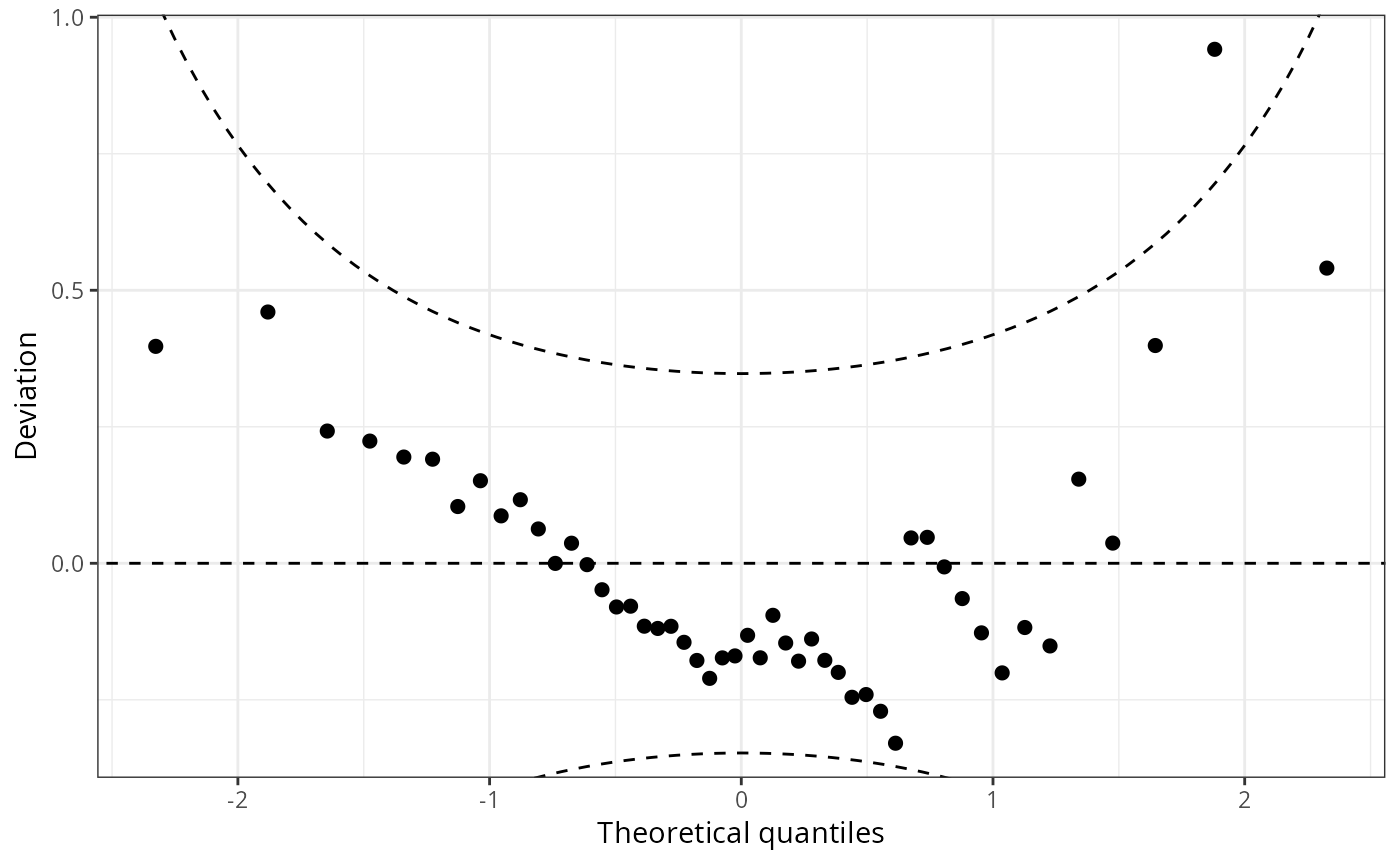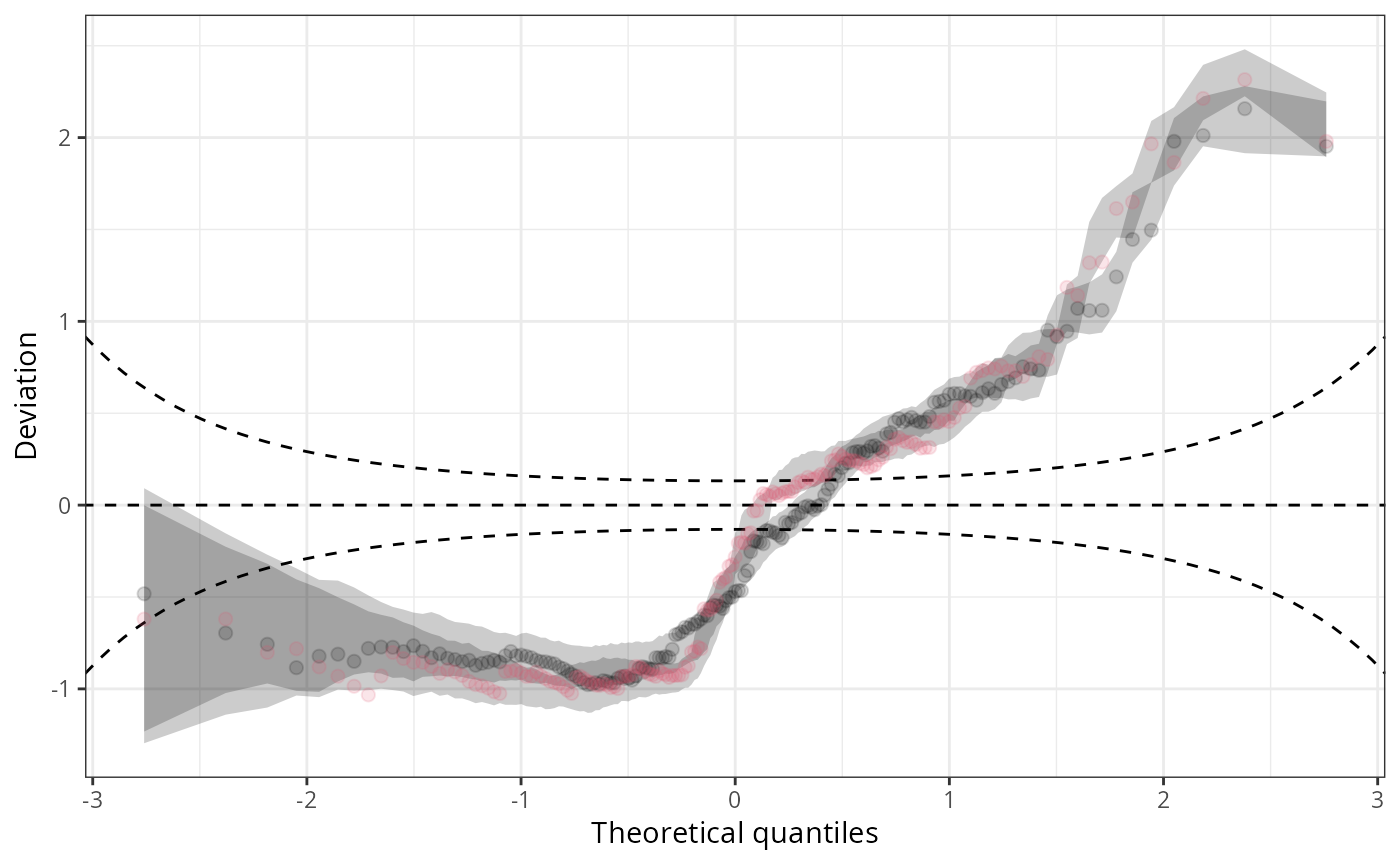Worm Plots for Quantile Residuals
wormplot.RdVisualize goodness of fit of regression models by worm plots using quantile
residuals. If plot = TRUE, the resulting object of class
"wormplot" is plotted by plot.qqrplot or
autoplot.qqrplot before it is returned, depending on whether the
package ggplot2 is loaded.
wormplot(object, ...)
# S3 method for default
wormplot(
object,
newdata = NULL,
plot = TRUE,
class = NULL,
detrend = TRUE,
scale = c("normal", "uniform"),
nsim = 1L,
delta = NULL,
confint = TRUE,
simint = TRUE,
simint_level = 0.95,
simint_nrep = 250,
single_graph = FALSE,
xlab = "Theoretical quantiles",
ylab = "Deviation",
main = NULL,
...
)Arguments
- object
an object from which probability integral transforms can be extracted using the generic function
procast.- newdata
optionally, a data frame in which to look for variables with which to predict. If omitted, the original observations are used.
- plot
Should the
plotorautoplotmethod be called to draw the computed Q-Q plot? Either setplotexpicitly to"base"vs."ggplot2"to choose the type of plot, or for a logicalplotargument it's chosen conditional if the packageggplot2is loaded.- class
Should the invisible return value be either a
data.frameor atibble. Either setclassexpicitly to"data.frame"vs."tibble", or forNULLit's chosen automatically conditional if the packagetibbleis loaded.- detrend
logical. Should the qqrplot be detrended, i.e, plotted as a `wormplot()`?
- scale
On which scale should the quantile residuals be shown: on the probability scale (
"uniform") or on the normal scale ("normal").- nsim, delta
arguments passed to
proresiduals.- confint
logical or character string describing the type for plotting `c("polygon", "line")`. If not set to `FALSE`, the pointwise confidence interval of the (randomized) quantile residuals are visualized.
- simint
logical. In case of discrete distributions, should the simulation (confidence) interval due to the randomization be visualized?
- simint_level
numeric. The confidence level required for calculating the simulation (confidence) interval due to the randomization.
- simint_nrep
numeric. The repetition number of simulated quantiles for calculating the simulation (confidence) interval due to the randomization.
- single_graph
logical. Should all computed extended reliability diagrams be plotted in a single graph?
- xlab, ylab, main, ...
graphical parameters passed to
plot.qqrplotorautoplot.qqrplot.
Value
An object of class "qqrplot" inheriting from
"data.frame" or "tibble" conditional on the argument class
with the following variables:
- x
theoretical quantiles,
- y
deviations between theoretical and empirical quantiles.
In case of
randomized residuals, nsim different x and y values, and
lower and upper confidence interval bounds (x_rg_lwr, y_rg_lwr,
x_rg_upr, y_rg_upr) can optionally be returned. Additionally,
xlab, ylab, main, and simint_level, as well as the
the (scale) and wether a detrended Q-Q residuals plot
was computed are stored as attributes.
Details
Worm plots (de-trended Q-Q plots) draw deviations of quantile residuals (by
default: transformed to standard normal scale) and theoretical quantiles from
the same distribution against the same theoretical quantiles. For computation,
wormplot leverages the function proresiduals
employing the procast.
Additional options are offered for models with discrete responses where randomization of quantiles is needed.
In addition to the plot and autoplot method for
wormplot objects, it is also possible to combine two (or more) worm plots by
c/rbind, which creates a set of worm plots that can then be
plotted in one go.
References
van Buuren S and Fredriks M (2001). “Worm plot: simple diagnostic device for modelling growth reference curves”. Statistics in Medicine, 20, 1259--1277. doi:10.1002/sim.746
See also
Examples
## speed and stopping distances of cars
m1_lm <- lm(dist ~ speed, data = cars)
## compute and plot wormplot
wormplot(m1_lm)
 #-------------------------------------------------------------------------------
## determinants for male satellites to nesting horseshoe crabs
data("CrabSatellites", package = "countreg")
## linear poisson model
m1_pois <- glm(satellites ~ width + color, data = CrabSatellites, family = poisson)
m2_pois <- glm(satellites ~ color, data = CrabSatellites, family = poisson)
## compute and plot wormplot as base graphic
w1 <- wormplot(m1_pois, plot = FALSE)
w2 <- wormplot(m2_pois, plot = FALSE)
## plot combined wormplot as "ggplot2" graphic
ggplot2::autoplot(c(w1, w2), single_graph = TRUE, col = c(1, 2), fill = c(1, 2))
#-------------------------------------------------------------------------------
## determinants for male satellites to nesting horseshoe crabs
data("CrabSatellites", package = "countreg")
## linear poisson model
m1_pois <- glm(satellites ~ width + color, data = CrabSatellites, family = poisson)
m2_pois <- glm(satellites ~ color, data = CrabSatellites, family = poisson)
## compute and plot wormplot as base graphic
w1 <- wormplot(m1_pois, plot = FALSE)
w2 <- wormplot(m2_pois, plot = FALSE)
## plot combined wormplot as "ggplot2" graphic
ggplot2::autoplot(c(w1, w2), single_graph = TRUE, col = c(1, 2), fill = c(1, 2))
